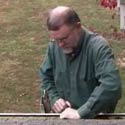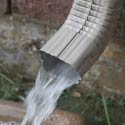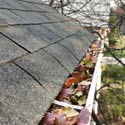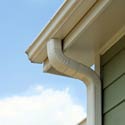Construction and Installation
Wood Gutters and Galvanized Downspouts
This was the traditional construction system employed and is rarely used today. The original wood gutters were made from old growth cedar, a product that is rarely available today. Its substitution with new growth cedar or hemlock gutters has proven inadequate. Galvanized downspouts do not tend to last as long the newer products available on the market.
Continuous Aluminum Gutters and Downspouts
This is the most common product used today. The gutter holds more water than traditional wood gutter, and this is the product, which is generally recommended. The one disadvantage of aluminum gutters is that they may tend to deform when a heavy ladder is leaned up against them. This is a minor shortcoming, which can be overcome by careful use of ladders.
When buying any metal gutters, choose the thickest you can afford – optimally .032 in. Though .027–, .025– and .019–in.–thick gutters are available, they won't hold up as well. When buying aluminum gutters, insist on primary aluminum, which is the thickest and most consistent kind. Avoid secondary aluminum, a recycled product that's often plagued by inconsistent thickness.
Vinyl and Plastic Gutters and Downspouts
This is a commonly used material and often sold in do-it-yourself hardware stores. It is easily installed by the homeowner, and when properly installed is a good product. It is also susceptible to damage by heavy ladders, as well as long-term deterioration by ultraviolet light from the sun.
Vinyl gutters, besides being impervious to rust and rot, are easiest to cut to size; you can install them yourself in a weekend or less. But vinyl can get brittle with age or in extreme cold. And while gutter sections cost just $3 to $5 per 10–ft. length, they still wind up at about $3 and $5 per linear foot installed when you factor in the cost of couplings, hangers and downspouts.
Integral Gutters
A popular gutter style in the 1960's was the integral gutter. The end of the rafters and fascia on a sloped roof forms this system. The gutter is lined with a built-up roofing material and has the advantage of being able to hold a great deal more water than most of the other types of gutters. The disadvantage of this gutter style is in the potential for leaks, which can result in damage to the framing, fascia, soffit, and sheathing of the roof. In order to prevent such damage, these gutters need to be carefully inspected every few years and the lining replaced or repaired every five to ten years. Should such a gutter system prove troublesome, it is possible to convert this gutter into a standard gutter configuration at the time of re-roofing.
Steel and Aluminum Gutters
These are the types most homeowners choose. With prices ranging from about $4 to $8 per linear foot installed, galvanized–steel gutters are the most economical. Steel gutters can stand up to ladders and fallen branches better than aluminum. But even thick galvanized steel eventually rusts through. Stainless-steel gutters are strong and rust-free, and maintain their high sheen for years. But as with other high-end custom materials, the drawback is cost: about $20 per linear foot. For this reason, galvanized-steel, aluminum or vinyl gutters are the predominant varieties.



